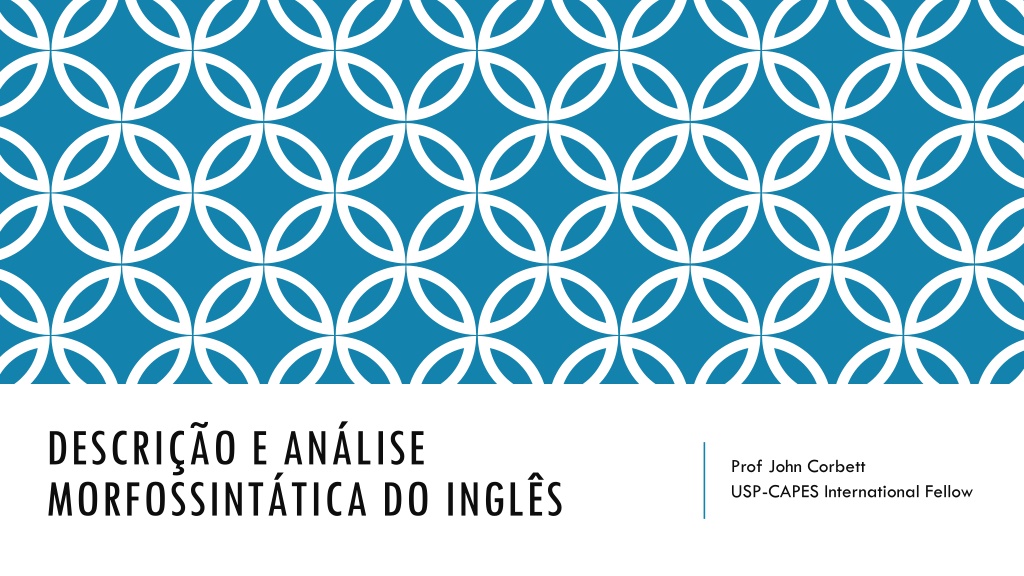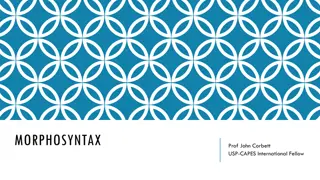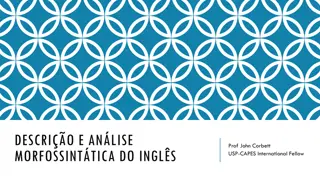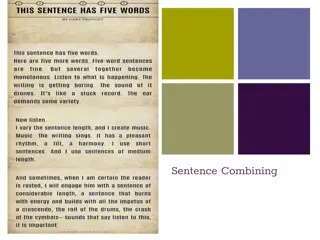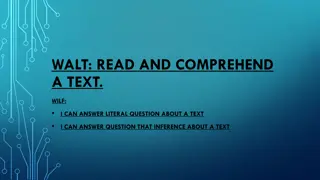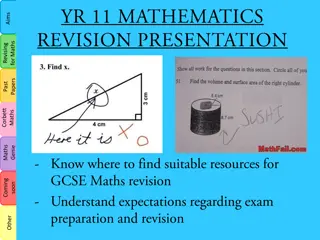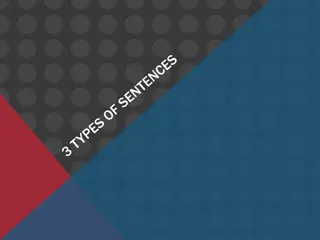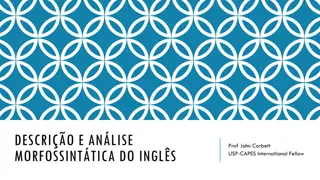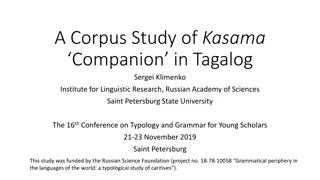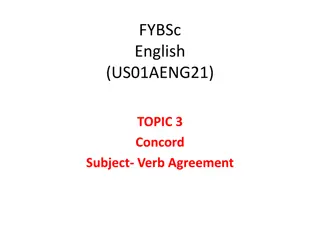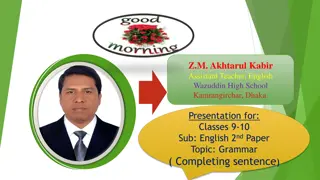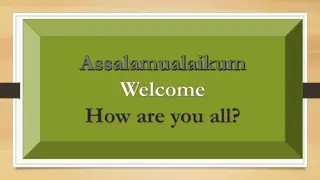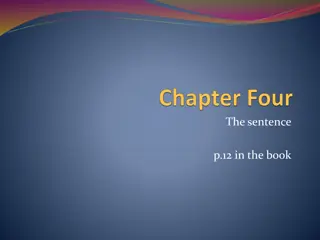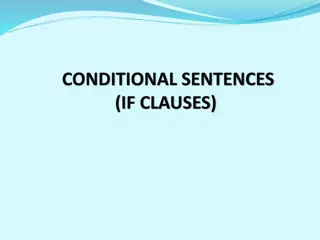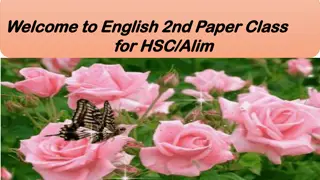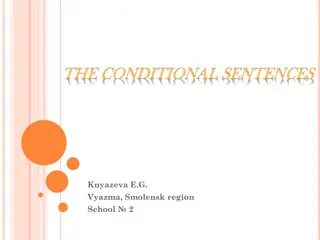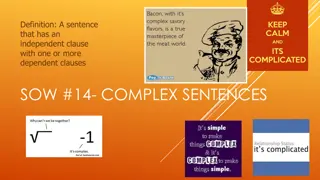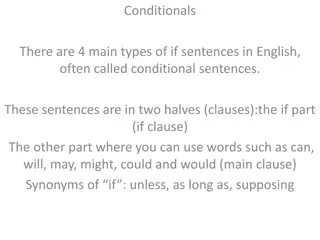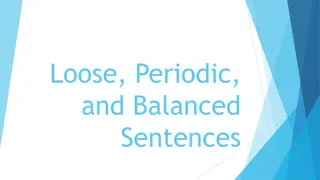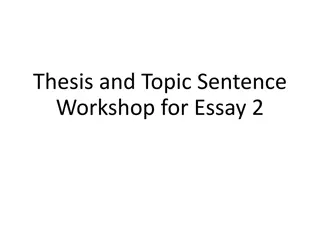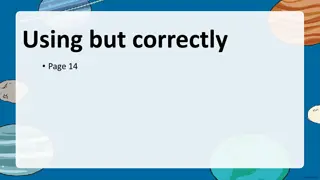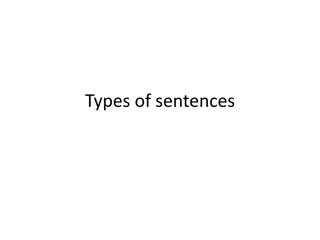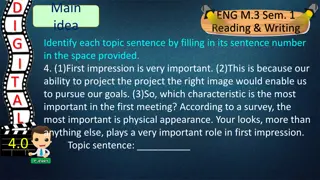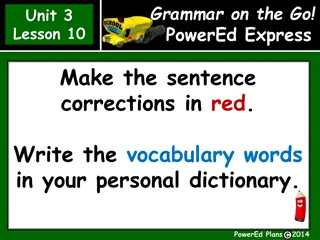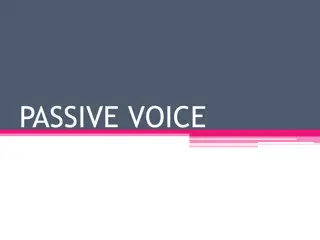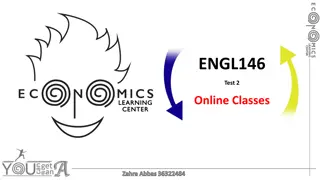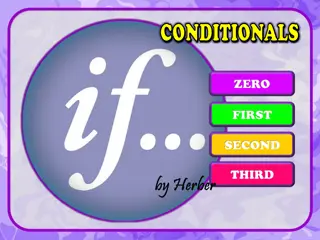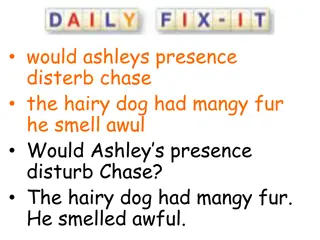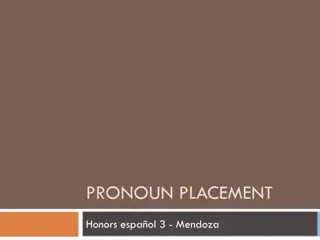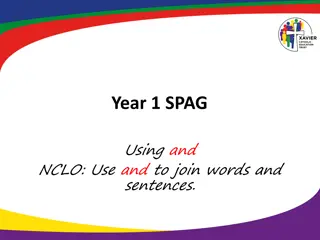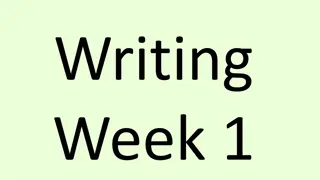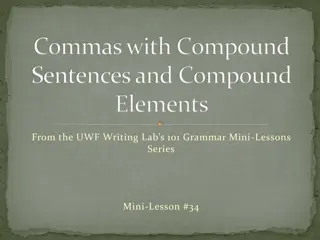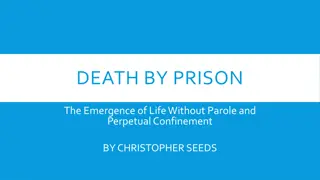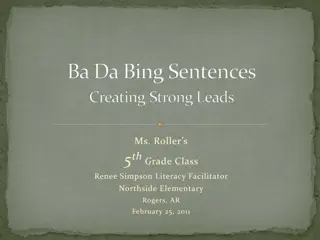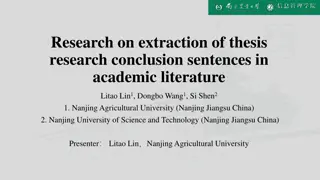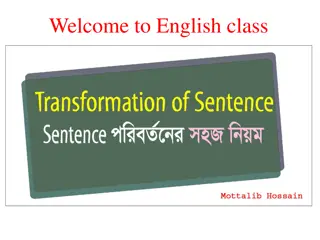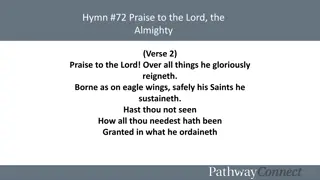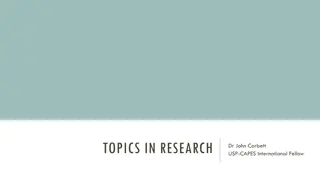Understanding the Morphosyntactic Analysis of English Sentences with Prof. John Corbett
Delve into the intricacies of sentence constituents, phrase structure, clause functions, and morphemes in English sentences as explained by Prof. John Corbett, an International Fellow at USP-CAPES. Explore how phrases combine and relate to each other, and learn about the structure of clauses and the functional values attributed to phrases within them.
Download Presentation

Please find below an Image/Link to download the presentation.
The content on the website is provided AS IS for your information and personal use only. It may not be sold, licensed, or shared on other websites without obtaining consent from the author. Download presentation by click this link. If you encounter any issues during the download, it is possible that the publisher has removed the file from their server.
E N D
Presentation Transcript
DESCRIO E ANLISE MORFOSSINT TICA DO INGL S Prof John Corbett USP-CAPES International Fellow
THE RANK SCALE Sentence Constituents: Sentence: Clause (SPOCA): Phrase (x M H): Word: Morpheme: Main clause(s) plus possible subordinate clauses. Subject/Predicator/Object/Complement/Adverbial Noun Phrase/Verb Phrase/Prepositional Phrase, etc. Noun/Verb/Adjective/Preposition, etc. prefixes, roots and suffixes
THE RANK SCALE Sentence Constituents: Sentence: Clause (SPOCA): Phrase (x M H): Word: Morpheme: Main clause(s) plus possible subordinate clauses. Subject/Predicator/Object/Complement/Adverbial Noun Phrase/Verb Phrase/Prepositional Phrase, etc. Noun/Verb/Adjective/Preposition, etc. prefixes, roots and suffixes Phrase structure is about the internal structure of phrases (eg inside a NP, what functions as modifier, headword or neither?) Clause structure is about how phrases combine in larger structures, such as sentences (eg is the NP functioning as the Subject or the Object of a sentence?)
FROM 2 WEEKS AGO My motorbike is really fast. My motorbike goes really fast. How many phrases are in each sentence? How do they relate to each other? In other words, how do the phrases combine?
FROM 2 WEEKS AGO My motorbike is really fast. My motorbike goes really fast. S M H P H C M H (My motorbike) (is) (really fast). NP d N VP V AjP Av Aj S M H P H A M H (My motorbike) (goes) (really fast). NP d N VP V AvP Av Av
CLAUSE STRUCTURE Clause functions (SPOCA) The NP (The mad dogs) has a different function in each of the following two sentences: The mad dogs were chasing him round the field. Health inspectors have captured the mad dogs. The VPs (were chasing) (have captured) and the PP (round the field) also have functional values in relation to the other phrases in each sentence.
CLAUSE STRUCTURE Clause functions (SPOCA) Subject Predicator Object Complement Adverbial These are functional values we give to phrases. Each clause is made up of a combination of one or more phrases with one of these functional values.
CLAUSE STRUCTURE Predicator The Predicator is always the VP. P The mad dogs (were chasing) him round the field. VP P He (was being chased) by the mad dogs. VP P Health inspectors (have captured) the mad dogs. VP Note: We put the functional label above the line of the sentence, and the form label below.
CLAUSE STRUCTURE Predicator The Predicator is always the VP. Identify the Predicators in the sentences below: Tam looked at me for a moment as I slammed the door shut, but remained silent. I could see that Richie was providing the sandwiches from the plastic lunch box, perched on his lap. He swigged the Irn Bru and handed it to Tam.
CLAUSE STRUCTURE Predicator = VP Tam looked at me for a moment as I slammed the door shut, but remained silent. I could see that Richie was providing the sandwiches from the plastic lunch box, perched on his lap. He swigged the Irn Bru and handed it to Tam. Clues to help identify VP/Predicators: Form: -ed (Past Tense inflexion) Function: Auxiliary verb + Main Verb could see was providing Meaning: Actions and states
CLAUSE STRUCTURE Subject The Subject has a relation of agreement or concord with the Predicator. S P (The mad dogs) (were chasing) him round the field. NP VP S P (He) (was being chased) by the mad dogs. NP VP
CLAUSE STRUCTURE Subject The Subject has a relation of agreement or concord with the Predicator. Identify the Subject in the following sentences: Tam looked at me for a moment as I slammed the door shut, but remained silent. I could see that Richie was providing the sandwiches from the plastic lunch box, perched on his lap. He swigged the Irn Bru and handed it to Tam.
CLAUSE STRUCTURE Subject The Subject has a relation of agreement or concord with the Predicator. Identify the Subject in the following sentences: Tam looked at me for a moment as I slammed the door shut, but remained silent. I could see that Richie was providing the sandwiches from the plastic lunch box, [ ] perched on his lap. He swigged the Irn Bru and [ ] handed it to Tam.
CLAUSE STRUCTURE Object The Object has the potential to become the Subject of a passive sentence. S P O (The mad dogs) (were chasing) (him) round the field. = active NP VP NP S P (He) (was being chased) round the field by the mad dogs. = passive NP VP Not: * Round the field was being chased him by the mad dogs.
CLAUSE STRUCTURE Object The Object has the potential to become the Subject of a passive sentence. Identify the Objects in the following sentences: Tam looked at me for a moment as I slammed the door shut, but remained silent. I could see that Richie was providing the sandwiches from the plastic lunch box, perched on his lap. He swigged the Irn Bru and handed it to Tam..
CLAUSE STRUCTURE Object The Object has the potential to become the Subject of a passive sentence. Identify the Objects in the following sentences: Tam looked at me for a moment as I slammed the door shut, but remained silent. I could see that Richie was providing the sandwiches from the plastic lunch box, perched on his lap. He swigged the Irn Bru and handed it to Tam..
CLAUSE STRUCTURE Direct and Indirect Object Some sentences have two NP s either of which can become Subject S O O (Those dogs ) gave (him) (a terrible fright). NP NP NP S O (He) was given (a terrible fright) by those dogs. NP NP or S O (A terrible fright) was given (him) by those dogs. NP NP
CLAUSE STRUCTURE In such cases, only one NP can be expanded into a PP. Here it is (him): Those dogs gave a terrible fright to him. A terrible fright was given to him by those dogs. NP s which do not expand into PP s are called Direct Objects. NP s which can expand into PP s are called Indirect Objects. (However, once they are expanded into a PP, they become Adverbials.) S A (A terrible fright) was given (to him) by those dogs. NP PP
CLAUSE STRUCTURE Complement The Complement is usually an AjP or a NP. Unlike the Object, it cannot become the Subject of a passive sentence. C Those kittens look (really cute). AjP *(Really cute) is looked by those kittens. C He has become (an accomplished actor). NP *(An accomplished actor) has been become by him. Complements usually describe or give value to the Subject or Object.
CLAUSE STRUCTURE Complement Complements usually describe or give value to the Subject or Object: Subject Complement: The desert can be dry.
CLAUSE STRUCTURE Subject and Object Complements Complements usually describe or give value to the Subject or Object: Subject Complement: The desert can be dry. Object Complement: We drank the city dry.
CLAUSE STRUCTURE Complement The Complement is usually an AjP or a NP. Unlike the Object, it cannot become the Subject of a passive sentence. Identify the two examples of a Complement in the following sentences: Tam looked at me for a moment as I slammed the door shut, but remained silent. I could see that Richie was providing the sandwiches from the plastic lunch box, perched on his lap. He swigged the Irn Bru and handed it to Tam..
CLAUSE STRUCTURE Complement Tam looked at me for a moment as I slammed the door shut, but remained silent. I could see that Richie was providing the sandwiches from the plastic lunch box, perched on his lap. He swigged the Irn Bru and handed it to Tam. shut = Object Complement (door=shut) in I slammed the door shut. silent = Subject Complement (Tam=silent) Tam remained silent.
CLAUSE STRUCTURE Adverbial Adverbials are usually AvP s or PP s which give information about time, place, manner and so on. They can often move around a sentence, or they can be left out altogether. A A The dogs attacked me (furiously). The dogs attacked me (with great fury). AvP PP A A The dogs (furiously) attacked me. The dogs, (with great fury), attacked me. AvP PP A A (Furiously), the dogs attacked me. (With great fury) the dogs attached me. AvP PP
CLAUSE STRUCTURE Adverbial Adverbials are usually AvP s or PP s which give information about time, place, manner and so on. They can often move around a sentence, or they can be left out altogether. A A The dogs attacked me (furiously). The dogs attacked me (with great fury). AvP PP Note that the adverbial can be left out and the sentence will still be complete. S P O (The dogs) (attacked) (me). NP VP NP
CLAUSE STRUCTURE Adverbial Adverbials are usually AvP s or PP s which give information about time, place, manner and so on. Identify the Adverbials in the following sentences: Tam looked at me for a moment as I slammed the door shut, but remained silent. I could see that Richie was providing the sandwiches from the plastic lunch box, perched on his lap. He swigged the Irn Bru and handed it to Tam..
CLAUSE STRUCTURE Tam looked at me for a moment as I slammed the door shut, but remained silent. I could see that Richie was providing the sandwiches from the plastic lunch box, perched on his lap. He swigged the Irn Bru and handed it to Tam. NB: to Tam is an Adverbial here. If the sentence had been He handed (Tam) (the Irn Bru) then it would be Oi. Q: What kind of words have not yet been analysed? (That is, the ones in black )
CLAUSE STRUCTURE Tam looked at me for a moment as I slammed the door shut, but remained silent. I could see that Richie was providing the sandwiches from the plastic lunch box, perched on his lap. He swigged the Irn Bru and handed it to Tam. Q: What kind of words have not yet been analysed? A: Conjunctions: as, but, that, and
CLAUSE STRUCTURE ANALYSIS S P A A (Tam) (looked) (at me) (for a moment) NP VP PP PP S P O Co as (I) (slammed) (the door) (shut), NP VP NP AjP P Cs but (remained) (silent). VP AjP This is a complex sentence, made up of an embedded clause and two coordinate clauses: [Tam looked at me for a moment [as I slammed the door shut]] but [remained silent]
MORE ON SENTENCE STRUCTURE NEXT WEEK! Don t forget the moodle quiz!
